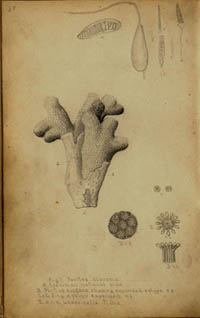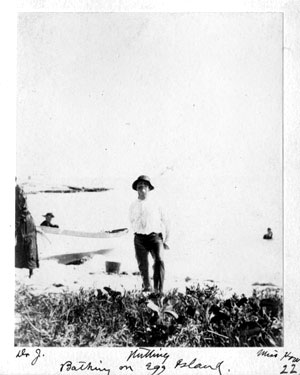
What began as a summer project
for me, became something much more meaningful when I was introduced to a man
named Charles Cleveland Nutting. The 265-page narrative of a scientific expedition
seemed quite a diversion to what I had been studying up until that point.
As an art history major, I was much more likely to understand the terms chiaroscuro
and baroque rather than gastropod and bivalve.
Surprisingly I quickly found that I was picking up C. C. Nutting's book to
read for pleasure rather than out of duty. The leader of the expedition's
hilarious accounts of the expedition made me laugh aloud. Not one word in
his narrative was unkind, and no one who was on the trip went unmentioned.
In addition to duly thanking every member of his crew, he often included humorous,
sometimes salutary stories about his fellow scientists.
I became enthralled with C. C. Nutting as a person and did some digging about
his life outside of scientific expeditions. He was an influential man on campus
and a loving man to his children. My research confirmed that this man was
a popular and well-respected scientist and individual. Books and articles
championed him as a modern man, a pioneer, an interesting orator whose lectures
sold out of space every time he gave speeches about his expedition. In fact,
the only fault I could find about him was that he wrote a little too sentimentally
in some of his accounts. One cannot fault him for that, as I am wont to do
the same when I write about the man.
As you get older, it seems that you acquire fewer heroes in life. I was lucky
to quite unexpectedly discover one this summer. I found a hero in Charles
Cleveland Nutting.
........Cynthia Simpson
**********************************
Charles Cleveland Nutting

C. C. Nutting, as he signed his papers, was
born Charles Cleveland Nutting, May 25, 1858 in Jacksonville, Illinois. The
future naturalist who would later champion Darwin was born to a long line of
religious men. His father Reverend Rufus Nutting Junior was Doctor of Divinity.
Charles was an early adventurer. In high school
he was already planning expeditions with his friends. One such expedition was
to go to Central America with two of his classmates. "They were going to
paddle down the Mississippi and across the Gulf of Mexico."(Taylor, 1943,
p. 272). It comes no surprise to find out that later in Nutting's life his library
would hold the complete works of Mark Twain.
Charles met his future wife Lizzie Hersman at
Blackburn College. They were married, August 10, 1886, the same year that Charles
came to Iowa City to work as curator of the museum and instructor in Natural
Science under Samuel Calvin. Before this was to occur, however, Charles had
some exploring to do. He spent a year in Colorado before he went to Costa Rica
in 1882 to study birds. He brought back to the United States National Museum
(Smithsonian) over 300 birds.
Charles Nutting's main interests were marine life
and museum work. In 1889 he became head of systematic zoology. His work and
his passions led him on expeditions around the world. His most famous expedition
was one organized by him and two other professors, which took them to the Bahamas
and Dry Islands in 1893. The twenty one-member expedition included students
who graduated while on the trip (Stromsen, 1950, p. 19). Other expeditions included
the Albatross expedition in 1902, The Laysan Island Expedition (1911)
and a trip to Fiji and New Zealand (1922) that he organized with two of the
professors who were involved in the Barbados and Antigua Expedition (1918).

Nutting felt very strongly about having a wide variety of specimens for his
students to observe and learn from.
"The best, and ordinarily the only, satisfactory way to secure material
is to go after it yourself, or send thoroughly competent men. These men should
be not only naturalists, but highly trained collectors." (Nutting from
Museum Methods, 1917). In this case Nutting was one of the most competent men
in his field. His expert opinion was held in the the highest regard. His expertise
came from his willingness to seek out his own specimens.
The modern scientist is not likely to be branching
out of his specialty to study adjacent subjects. The old school naturalist,
epitomized by Nutting was free to preserve and classify birds, insects, plants,
and other specimens brought back from numerous field trips. Nutting was interested
in everything; he asked questions, wrote things down and pursued information
about them with passion. Nutting believed in popular science and that by interesting
the average person in his projects, he felt that he was fostering a growth of
science. (Taylor, 1943, p. 279).
No wonder Nutting was popular as an instructor.
In addition to taking students with him to different parts of the globe, his
knowledge and passion for education extended into the classroom. His lectures
were always interesting and included photos from his trip to help with the narration.
The packed assemblies indicated his success as an orator.
Professor Nutting was concerned with the
values that a student gained as well as their standard education. "Darwin
was right when he said that the very worst method of imparting scientific instruction
was the lecture system. Natural science can be taught properly only when the
student, the specimens, and a competent instructor are brought together; and
this can not be done by mass instruction." This quote is taken from Nutting's
book Values, published July 27, 1920 in which he describes real soul
values. Nutting expresses his concern for the turn that education is taking.
He worried that institutions of learning were turning out students who were
prepared to make a living, without the guidance in how to live.
There is no doubt that students under Professor
Nutting's instruction, were given the opportunity to really live. In fact they
helped build the University's collection of biological specimens. The collection
expanded and took systematic form under Professor Nutting's care as curator
of the museum, a position he held until 1926.
As the museums collection grew, so did Nutting's
concern for their storage. The collection consisted of hundreds of boxes piled
in the attic. He persistently asked for proper conditions to house the valuable
specimens but his true and great goal was to have a complete museum in which
the entire collection could be displayed. Professor Nutting dreamed of a museum
with a great zoology department with a "study" museum and a "collection
of animals so complete and arranged that it would illustrate the evolutionary
progress of life in order that students could see that progress graphically,
vividly illustrated." (Taylor, 1943, p. 286).

The ideal museum would
be a beautiful building, strong and fireproof and adorned outside with animal
heads, turtles, fish and leaves. And indeed, in 1905 a fine stone building was
competed and was to be called the Natural Science Building (now Macbride
Hall). It was supposed to house all branches of the old "Cabinet of
Natural History" as well as the museums and herbarium. This plan went up
in smoke when fire struck the old North Hall and the library was moved to the
new science building taking over the first floor and basement while an auditorium
took what space was left on the second and third floors. Only the two ends were
given to the museum and zoology department while the geology and botany were
left across the street to be moved later (Iowa Alum. 21). In 1926, the year
before Professor Nutting died, his department was moved completely out of the
Natural Science Building and into a vacated medical college building (Taylor,
1943).
Professor Nutting stood behind his department
and the museum through everything. When fighting for what he believed in, Nutting
was known to stand up to the President of the University. "He was not afraid
to antagonize the whole world if in that manner he thought he could accomplish
a desirable purpose. His sincerity was never questioned, he was respected for
it, and no one seems to have been appointed to more committees than he. (Taylor,
1943, p. 289)."
While things changed at the University, so did
Charles Nutting's personal life. Lizzie passed away after the birth of their
daughter Caroline, and Charles' sister Catherine moved in to help with the family.
Charles was a loving father and respected his daughter so much that it was her
permission he sought when he wished to ask Eloise Willis to be his wife (Taylor,
1943). It was Caroline who proposed to her future step-mother and in addition
to a new mother, she later gained two step-brothers. Willis Nutting and Charles
(Carl) Nutting went with Charles and his new wife on expeditions and helped
a great deal with the Barbados and Antigua expedition.
C. C. Nutting died January 23, 1927 at his home
in Iowa City. He had been with the University of Iowa for over forty years (Taylor,
1943). While it is true that he did suffer health problems during the last years
of his life he staunchly ignored them and continued to go about his daily life
never making reference to them. It was the changing outlook on science by others
that hurt him more than any physical ailments. People refer to him as one of
the "great triumvirate" of the University which included Professors
Calvin and Macbride (Taylor, 1943). Nutting left a legacy at the University
that will not be forgotten despite the lack of a building in his honor. His
ideals and real soul values influenced everyone with whom he came into contact.
His work and his words continue to inspire people today.